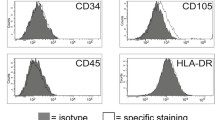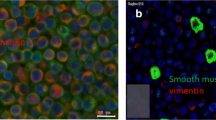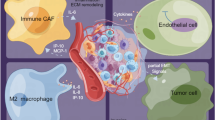Abstract
Objectives
Cancer progression is influenced by tumor microenvironment and communication of stromal cells and tumor cells. Interactions may enhance epithelial-mesenchymal transition (EMT) of tumor cells through signaling proteins such as Wnt/beta-catenin and matrix metalloproteinases (MMP), as well as loss of cellular integrity, which affects invasion, progression, and metastasis of head and neck squamous cell carcinoma (HNSCC). In this study, we are testing the hypothesis that interactions of human mesenchymal stromal cells (MSCs) with HNSCC might influence the expression of markers of EMT and tumor progression by co-culturing human MSC with the PCI-13 HNSCC line.
Materials and methods
Pooled MSCs were derived from the iliac bone marrow of seven patients and co-cultured in transwell permeable membrane wells with tumor cells of the established HNSCC cell line PCI-13 (UICC: T3, N1, M0). MSCs were characterized through fluorescence-activated cell sorting (FACS) analysis. Expression of Wnt3, E-cadherin, beta-catenin, MMP14, cathepsin b, and ETS1 was assessed by quantitative RT-PCR.
Results
We were able to show that co-culture of MSCs and PCI-13 leads to a significantly reduced expression of Wnt3, MMP14, and beta-catenin compared to controls, whereas the expression of cathepsin b and ETS1 was not significantly different between co-cultures and controls.
Conclusion
Our results suggest that the interaction between MSCs and PCI-13 may suppress EMT in cancer cells.
Clinical relevance
The influence of MSCs can suppress the onset of EMT in HNSCC, affecting tumor progression and therapy.





Similar content being viewed by others
References
Smith A, Teknos TN, Pan Q (2013) Epithelial to mesenchymal transition in head and neck squamous cell carcinoma. Oral Oncol 49(4):287–292. doi:10.1016/j.oraloncology.2012.10.009
Routray S, Sunkavali A, Bari K (2013) Carcinoma-associated fibroblasts, its implication in head and neck squamous cell carcinoma: a mini review. Oral Dis. doi:10.1111/odi.12107
Fierro FA, Sierralta WD, Epunan MJ, Minguell JJ (2004) Marrow-derived mesenchymal stem cells: role in epithelial tumor cell determination. Clin Exp Metastsis 21(4):313–319
Qiao L, Xu Z, Zhao T, Zhao Z, Shi M, Zhao RC, Ye L, Zhang X (2008) Suppression of tumorigenesis by human mesenchymal stem cells in a hepatoma model. Cell Res 18(4):500–507. doi:10.1038/cr.2008.40
Gottschling S, Granzow M, Kuner R, Jauch A, Herpel E, Xu EC, Muley T, Schnabel PA, Herth FJ, Meister M (2013) Mesenchymal stem cells in non-small cell lung cancer—different from others? Insights from comparative molecular and functional analyses. Lung Cancer 80(1):19–29. doi:10.1016/j.lungcan.2012.12.015
Nishimura K, Semba S, Aoyagi K, Sasaki H, Yokozaki H (2012) Mesenchymal stem cells provide an advantageous tumor microenvironment for the restoration of cancer stem cells. Pathobiology 79(6):290–306. doi:10.1159/000337296
Gos M, Miloszewska J, Przybyszewska M (2009) Epithelial-mesenchymal transition in cancer progression. Postepy Biochem 55(2):121–128
Higashikawa K, Yoneda S, Taki M, Shigeishi H, Ono S, Tobiume K, Kamata N (2008) Gene expression profiling to identify genes associated with high-invasiveness in human squamous cell carcinoma with epithelial-to-mesenchymal transition. Cancer Lett 264(2):256–264. doi:10.1016/j.canlet.2008.01.045
Aprelikova O, Palla J, Hibler B, Yu X, Greer YE, Yi M, Stephens R, Maxwell GL, Jazaeri A, Risinger JI, Rubin JS, Niederhuber J (2012) Silencing of miR-148a in cancer-associated fibroblasts results in WNT10B-mediated stimulation of tumor cell motility. Oncogene 32(27):3246–3253. doi:10.1038/onc.2012.351
Hakim SG, Kosmehl H, Sieg P, Trenkle T, Jacobsen HC, Attila Benedek G, Ribbat J, Driemel O (2011) Altered expression of cell-cell adhesion molecules beta-catenin/E-cadherin and related Wnt-signaling pathway in sporadic and syndromal keratocystic odontogenic tumors. Clin Oral Investig 15(3):321–328. doi:10.1007/s00784-010-0388-8
Yi N, Liao QP, Li ZH, Xie BJ, Hu YH, Yi W, Liu M (2013) RNA interference-mediated targeting of DKK1 gene expression in Ishikawa endometrial carcinoma cells causes increased tumor cell invasion and migration. Oncol Lett 6(3):756–762. doi:10.3892/ol.2013.1439
Ulasov I, Thaci B, Sarvaiya P, Yi R, Guo D, Auffinger B, Pytel P, Zhang L, Kim CK, Borovjagin A, Dey M, Han Y, Baryshnikov AY, Lesniak MS (2013) Inhibition of MMP14 potentiates the therapeutic effect of temozolomide and radiation in gliomas. Cancer Med 2(4):457–467. doi:10.1002/cam4.104
Devy L, Huang L, Naa L, Yanamandra N, Pieters H, Frans N, Chang E, Tao Q, Vanhove M, Lejeune A, van Gool R, Sexton DJ, Kuang G, Rank D, Hogan S, Pazmany C, Ma YL, Schoonbroodt S, Nixon AE, Ladner RC, Hoet R, Henderikx P, Tenhoor C, Rabbani SA, Valentino ML, Wood CR, Dransfield DT (2009) Selective inhibition of matrix metalloproteinase-14 blocks tumor growth, invasion, and angiogenesis. Cancer Res 69(4):1517–1526. doi:10.1158/0008-5472.CAN-08-3255
Zhang W, Matrisian LM, Holmbeck K, Vick CC, Rosenthal EL (2006) Fibroblast-derived MT1-MMP promotes tumor progression in vitro and in vivo. BMC Cancer 6:52. doi:10.1186/1471-2407-6-52
Rosenthal EL, McCrory A, Talbert M, Carroll W, Magnuson JS, Peters GE (2004) Expression of proteolytic enzymes in head and neck cancer-associated fibroblasts. Arch Otolaryngol Head Neck Surg 130(8):943–947. doi:10.1001/archotol.130.8.943
Casarsa C, Bassani N, Ambrogi F, Zabucchi G, Boracchi P, Biganzoli E, Coradini D (2011) Epithelial-to-mesenchymal transition, cell polarity and stemness-associated features in malignant pleural mesothelioma. Cancer Lett 302(2):136–143. doi:10.1016/j.canlet.2011.01.009
Findlay VJ, LaRue AC, Turner DP, Watson PM, Watson DK (2013) Understanding the role of ETS-mediated gene regulation in complex biological processes. Adv Cancer Res 119:1–61. doi:10.1016/B978-0-12-407190-2.00001-0
Saunders LR, McClay DR (2014) Sub-circuits of a gene regulatory network control a developmental epithelial-mesenchymal transition. Development 141(7):1503–1513. doi:10.1242/dev.101436
Reiser J, Adair B, Reinheckel T (2010) Specialized roles for cysteine cathepsins in health and disease. J Clin Invest 120(10):3421–3431. doi:10.1172/JCI42918
Oliver JR, Kushwah R, Hu J (2012) Multiple roles of the epithelium-specific ETS transcription factor, ESE-1, in development and disease. Lab Invest 92(3):320–330. doi:10.1038/labinvest.2011.186
Bengsch F, Buck A, Gunther SC, Seiz JR, Tacke M, Pfeifer D, von Elverfeldt D, Sevenich L, Hillebrand LE, Kern U, Sameni M, Peters C, Sloane BF, Reinheckel T (2013) Cell type-dependent pathogenic functions of overexpressed human cathepsin B in murine breast cancer progression. Oncogene. doi:10.1038/onc.2013.395
Mohamed MM, Sloane BF (2006) Cysteine cathepsins: multifunctional enzymes in cancer. Nat Rev Cancer 6(10):764–775. doi:10.1038/nrc1949
Gocheva V, Zeng W, Ke D, Klimstra D, Reinheckel T, Peters C, Hanahan D, Joyce JA (2006) Distinct roles for cysteine cathepsin genes in multistage tumorigenesis. Genes Dev 20(5):543–556. doi:10.1101/gad.1407406
Tang N, Xie Q, Wang X, Li X, Chen Y, Lin X, Lin J (2011) Inhibition of invasion and metastasis of MHCC97H cells by expression of snake venom cystatin through reduction of proteinases activity and epithelial-mesenchymal transition. Arch Pharm Res 34(5):781–789. doi:10.1007/s12272-011-0512-6
Snyderman CH, Klapan I, Milanovich M, Heo DS, Wagner R, Schwartz D, Johnson JT, Whiteside TL (1994) Comparison of in vivo and in vitro prostaglandin E2 production by squamous cell carcinoma of the head and neck. Otolaryngol Head Neck Surg 111(3 Pt 1):189–196
Heo DS, Snyderman C, Gollin SM, Pan S, Walker E, Deka R, Barnes EL, Johnson JT, Herberman RB, Whiteside TL (1989) Biology, cytogenetics, and sensitivity to immunological effector cells of new head and neck squamous cell carcinoma lines. Cancer Res 49(18):5167–5175
Pfaffl MW (2001) A new mathematical model for relative quantification in real-time RT-PCR. Nucleic Acids Res 29(9):e45
Mravic M, Asatrian G, Soo C, Lugassy C, Barnhill RL, Dry SM, Peault B, James AW (2014) From pericytes to perivascular tumours: correlation between pathology, stem cell biology, and tissue engineering. Int Orthop 38(9):1819–1824. doi:10.1007/s00264-014-2295-0
Zhu W, Xu W, Jiang R, Qian H, Chen M, Hu J, Cao W, Han C, Chen Y (2006) Mesenchymal stem cells derived from bone marrow favor tumor cell growth in vivo. Exp Mol Path 80(3):267–274. doi:10.1016/j.yexmp.2005.07.004
Lu YR, Yuan Y, Wang XJ, Wei LL, Chen YN, Cong C, Li SF, Long D, Tan WD, Mao YQ, Zhang J, Li YP, Cheng JQ (2008) The growth inhibitory effect of mesenchymal stem cells on tumor cells in vitro and in vivo. Cancer Biol Ther 7(2):245–251
Zhu Y, Sun Z, Han Q, Liao L, Wang J, Bian C, Li J, Yan X, Liu Y, Shao C, Zhao RC (2009) Human mesenchymal stem cells inhibit cancer cell proliferation by secreting DKK-1. Leukemia 23(5):925–933. doi:10.1038/leu.2008.384
Lim YS, Lee JC, Lee YS, Lee BJ, Wang SG (2012) Growth inhibitory effect of palatine tonsil-derived mesenchymal stem cells on head and neck squamous cell carcinoma cells. Clin Exp Otorhinolaryngol 5(2):86–93. doi:10.3342/ceo.2012.5.2.86
Bagutti C, Speight PM, Watt FM (1998) Comparison of integrin, cadherin, and catenin expression in squamous cell carcinomas of the oral cavity. J Pathol 186(1):8–16. doi:10.1002/(SICI)1096-9896(199809)186:1<8::AID-PATH156>3.0.CO;2-H
Hung KF, Chang CS, Liu CJ, Lui MT, Cheng CY, Kao SY (2006) Differential expression of E-cadherin in metastatic lesions comparing to primary oral squamous cell carcinoma. J Oral Pathol Med 35(10):589–594. doi:10.1111/j.1600-0714.2006.00474.x
Kurtz KA, Hoffman HT, Zimmerman MB, Robinson RA (2006) Decreased E-cadherin but not beta-catenin expression is associated with vascular invasion and decreased survival in head and neck squamous carcinomas. Otolaryngol Head Neck Surg 134(1):142–146. doi:10.1016/j.otohns.2005.08.026
You DH, Nam MJ (2013) Effects of human epidermal growth factor gene-transfected mesenchymal stem cells on fibroblast migration and proliferation. Cell Prolif 46(4):408–415. doi:10.1111/cpr.12042
Hollestelle A, Peeters JK, Smid M, Timmermans M, Verhoog LC, Westenend PJ, Heine AA, Chan A, Sieuwerts AM, Wiemer EA, Klijn JG, van der Spek PJ, Foekens JA, Schutte M, den Bakker MA, Martens JW (2013) Loss of E-cadherin is not a necessity for epithelial to mesenchymal transition in human breast cancer. Breast Cancer Res Treat 138(1):47–57. doi:10.1007/s10549-013-2415-3
Brabletz T, Jung A, Reu S, Porzner M, Hlubek F, Kunz-Schughart LA, Knuechel R, Kirchner T (2001) Variable beta-catenin expression in colorectal cancers indicates tumor progression driven by the tumor environment. Proc Natl Acad Sci U S A 98(18):10356–10361. doi:10.1073/pnas.171610498
Pukkila MJ, Virtaniemi JA, Kumpulainen EJ, Pirinen RT, Johansson RT, Valtonen HJ, Juhola MT, Kosma VM (2001) Nuclear beta catenin expression is related to unfavourable outcome in oropharyngeal and hypopharyngeal squamous cell carcinoma. J Clin Pathol 54(1):42–47
Ravindran G, Devaraj H (2012) Aberrant expression of beta-catenin and its association with DeltaNp63, Notch-1, and clinicopathological factors in oral squamous cell carcinoma. Clin Oral Investig 16(4):1275–1288. doi:10.1007/s00784-011-0605-0
Rosado P, Lequerica-Fernandez P, Fernandez S, Allonca E, Villallain L, de Vicente JC (2013) E-cadherin and beta-catenin expression in well-differentiated and moderately-differentiated oral squamous cell carcinoma: relations with clinical variables. Br J Oral Maxillofac Surg 51(2):149–156. doi:10.1016/j.bjoms.2012.03.018
Liu LK, Jiang XY, Zhou XX, Wang DM, Song XL, Jiang HB (2010) Upregulation of vimentin and aberrant expression of E-cadherin/beta-catenin complex in oral squamous cell carcinomas: correlation with the clinicopathological features and patient outcome. Mod Pathol 23(2):213–224. doi:10.1038/modpathol.2009.160
Wang X, Zhang J, Fan M, Zhou Q, Deng H, Aisharif MJ, Chen X (2009) The expression of E-cadherin at the invasive tumor front of oral squamous cell carcinoma: immunohistochemical and RT-PCR analysis with clinicopathological correlation. Oral Surg Oral Med Oral Pathol Oral Radiol Endod 107(4):547–554. doi:10.1016/j.tripleo.2008.11.021
Mahomed F, Altini M, Meer S (2007) Altered E-cadherin/beta-catenin expression in oral squamous carcinoma with and without nodal metastasis. Oral Dis 13(4):386–392. doi:10.1111/j.1601-0825.2006.01295.x
Polakis P (2000) Wnt signaling and cancer. Genes Dev 14(15):1837–1851
Neth P, Ciccarella M, Egea V, Hoelters J, Jochum M, Ries C (2006) Wnt signaling regulates the invasion capacity of human mesenchymal stem cells. Stem Cells 24(8):1892–1903. doi:10.1634/stemcells. 2005-0503
Acknowledgments
The work was supported by the Clinic of Oral and Maxillofacial Surgery and the medical faculty of the Georg-August-University Göttingen, Germany. We are grateful to Jutta Schulz for her technical assistance.
Ethical standards
The isolation of human MSC was carried out in accordance with the patients’ informed consent and according to the guidelines and approval of the local ethics committee (no. 15/10/01) of the Georg-August-University Göttingen. It has therefore been performed in accordance with the ethical standards laid down in the 1964 Declaration of Helsinki and its later amendments.
Conflict of interest
The authors have no further interest in companies or other entities that have an interest in the information in the contribution. There is no conflict of interest pending.
Author information
Authors and Affiliations
Corresponding author
Rights and permissions
About this article
Cite this article
Böhrnsen, F., Fricke, M., Sander, C. et al. Interactions of human MSC with head and neck squamous cell carcinoma cell line PCI-13 reduce markers of epithelia-mesenchymal transition. Clin Oral Invest 19, 1121–1128 (2015). https://doi.org/10.1007/s00784-014-1338-7
Received:
Accepted:
Published:
Issue Date:
DOI: https://doi.org/10.1007/s00784-014-1338-7




